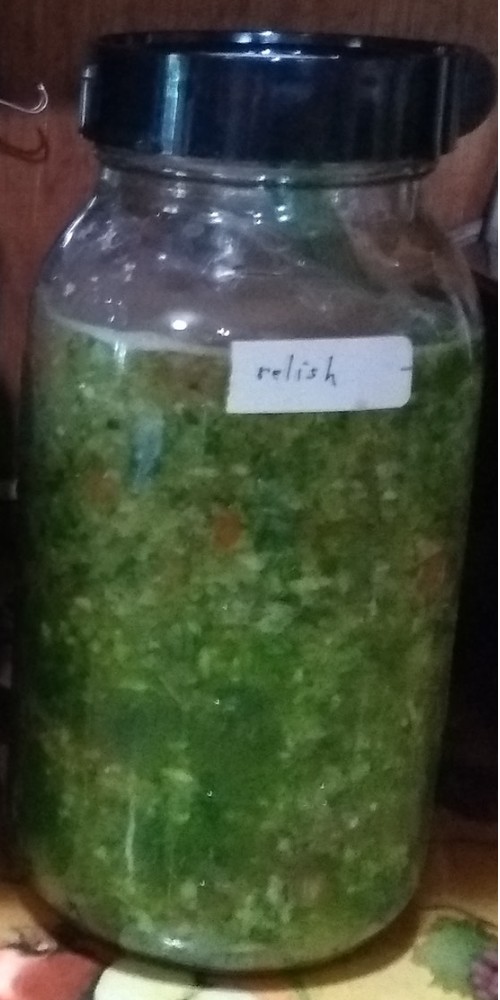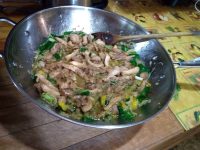
I suppose the easest thing to do if you need dill pickle relish for Amanda’s keto Big Mac Special Sauce copycat recipe, is that you could just dice up some garlic dill pickles instead.
But I really like this specific lacto-fermented cucumber relish recipe, which gives a bit more color and a different punch for things like hot dogs and burgers.
Give it a try! It may become one of your favorites too.
Fermentation Equipment
 my fermentation kit (affiliate link)
my fermentation kit (affiliate link)There’s a number of ways that you can ferment. Historically, it was done in a large crock, with the vegetables submerged under an appropriate brine and held done by a weight. In my experience, sometimes this works, and sometimes you get a moldy mess.
I feel that as far as moldy veggies go: ain’t nobody got time for that!
The ideal fermentation requires an airlock, so that mold spores and outside bacteria can’t touch the vegetables, while allowing the gases produced by fermentation to escape. I use the kit shown to the right, which fits any wide-mouth canning jar.
 wide mouth pint jars (affiliate link)
wide mouth pint jars (affiliate link)Unfortunately, the half gallons are a tad expensive; I have 6 and guard them closely! But you could split the recipe into pint-sized jars if you prefer.
hints
I prefer to use a red or orange bell pepepr, as the color contrasts nicely with the cukes, but any color bell pepper is fine.
I use bunching onions because I grow them in my garden, but you could substitute a medium onion (lsighlty higher carb, but given the actual serving size, it hardly matters).
A food processor with an S-blade will make vegetable preparation easy, making this recipe a snap!
Safe Brining
Regardless of the fermentation system you choose to use, the most important bit is having an appropriate brine. The right level of salt allows the beneficial lacto-bacteria to grow while preventing inappropriate bacteria from growing.
For dill pickles, I use a 5% brine. The volume of salt required depends on the type of salt you are using, as the size of the grains can vary. (Note: iodized salt is not recommended for pickling). Rather than try to figure out exactly how much you should measure by volume, it is simpler to weigh the salt.
The water used is critical also; chlorinated water may well kill off the lacto-bacteria necessary to do the fermentation. A standard Brita filter will remove the chlorine.
LACTO-FERMENTED CUCUMBER RELISH – Makes 3 pints.
INGREDIENTS
- 2 1/2 lbs cucucumbers (around 8 small cukes)
- 1 bell pepper
- 6 medium scallions
- 1 1/2 tsp mustard seed
- 1 1/2 tsp coriander seed
- 1.6 oz salt (45 gm)
- 1 quart non-chlorinated water
- liquid (whey) drained from plain yogurt (optional)
METHOD
- Sterilize a 1/2 gallon wide-mouth jar in boiling water.
- Wash cucumbers and place in food processor with S-blade.
- Halve the pepper and remove seeds and add it to the food processor also.
- Cut the white bit off the scallions and add it to the food processor too; reserve the green portion.
- Process the vegetables in the food processor using the “pulse” function until they’re the appropriate size.
- Cut the green bits of the scallions up with kitchen shears and add to the other veggies.
- Remove sterilized jar to folded kitchen towel after draining. In bottom of jar, place both spice seeds.
- Measure water and stir in salt. Mix in any available whey off yogurt or add a tsp of yogurt.
- Pour brine over vegetables, using weights of some sort to keep them below the liquid level if needed.
- Put on the air lock according to the manufacturers instructions and leave to ferment at room temperature for 3 days.
- Replace airlock with normal lid (loosely), label and refrigerate.

